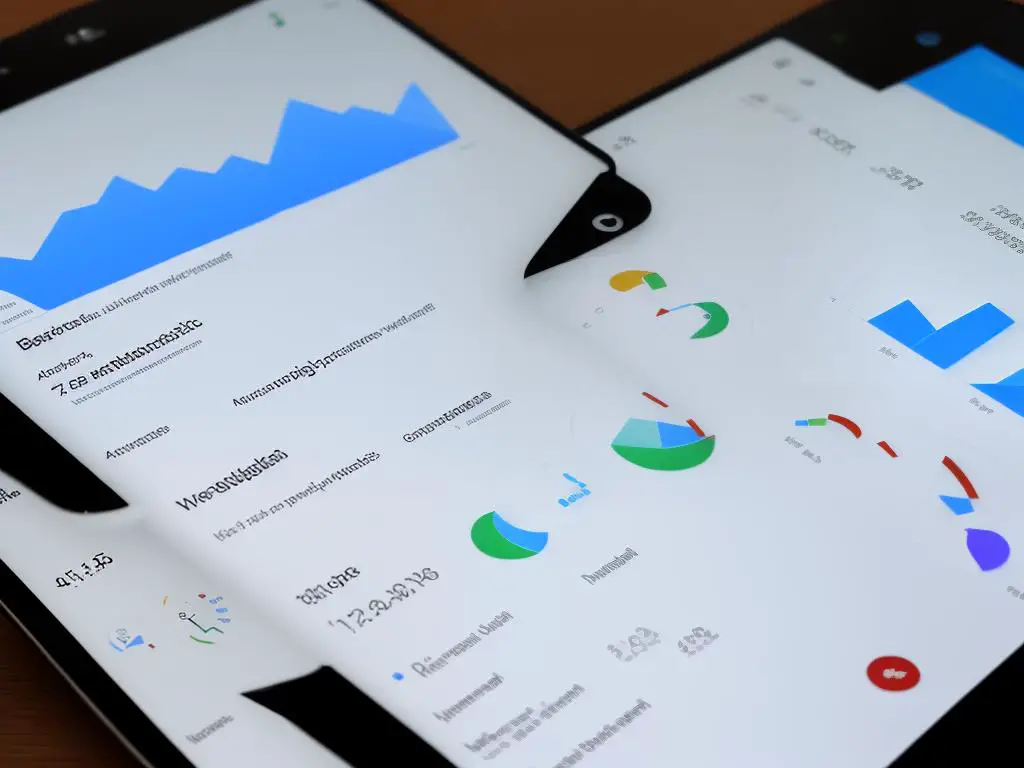In the ever-changing landscape of the digital age, the concepts of privacy and data protection have ascended to the forefront of major concerns. The mechanics behind data collection, storage, and usage are particularly important, considering their potential to intrude upon individual rights. Google Analytics 4 (GA4), the most recent iteration released by the tech giant, is a powerful tool used extensively for insights and analytics, posing significant impacts on user privacy. It’s essential for the general public, whether as casual internet surfers or website owners, to develop a strong grasp of how GA4 functions, its approach to privacy, and the control features offered by it. This comprehension not only prompts informed decisions but also furthers the cause of digital privacy.
Overview of Google Analytics 4 (GA4)
Google Analytics 4
Google Analytics 4, commonly known as GA4, is the latest version of the Google Analytics platform. This tool is universally recognized for measuring website and app traffic, helping businesses and individuals understand user behavior. GA4 brings a fresh approach to data analytics, vastly different from the previous versions, mainly Universal Analytics (UA).
GA4’s Data Modeling Approach
The key difference between GA4 and the conventional UA resides in their data modeling approach. GA4 capitalizes on an event-driven model, significantly contrasting the session and hit-based model of the earlier UA versions. To simplify, GA4 is more adapted to the way users interact with web and app properties today, tracking specific user interactions (events), which offer more nuanced insight into user behavior.
GA4 and Digital Privacy
GA4 is incredibly important to discussions about digital privacy. With the changing laws for data privacy and increasing awareness and demand by users for more transparent data practices, Google has redesigned Analytics with privacy at its core. Unlike its predecessor, GA4 is designed to adapt to a future with or without cookies or identifiers. This means that marketers can rely on GA4 for crucial insights, even as technology and standards for user privacy evolve.
Privacy Controls in GA4
The main highlight of GA4’s privacy controls is that it functions by default in a “privacy-safe way”, according to Google. This major shift in operation introduces new privacy features such as Consent Mode, which allows scope for users to consent or decline cookies or identifiers used for analytics and advertising. This means that businesses using GA4 can manage the way they collect, store and use data, ultimately respecting user preferences regarding privacy.
Additionally, GA4 introduces a more advanced set of controls for data deletion. This feature enables users to request the removal of their data from GA4 services, enhancing the privacy rights of individuals. It is a significant step towards a more privacy-focused, user-friendly world of analytics.
Data Sharing in GA4
GA4 also addresses the concern of data sharing. It lessens data sharing with Google, giving businesses the control they need over who can access their data. The collected data is solely used to provide and improve GA4 and won’t be shared across Google advertising products, maintaining the confidentiality of the user data.
Final Thoughts
Google Analytics 4 (GA4) is leading the way towards a new era of privacy control in the sector of digital analytics. User privacy is at the heart of its approach, with clear controls put in place to manage data collection, storage, and sharing. But GA4 isn’t just about privacy; it also equips businesses with crucial insights that support strategic decision-making. In a time where digital privacy is a hot topic, understanding the role and capabilities of tools like GA4 is paramount.

GA4’s Approach to Privacy
The Path of GA4 towards Privacy Control
GA4 is committed to delivering valuable data insights to businesses while maintaining unwavering respect for user privacy. The way it collects, stores and uses data is carefully designed to safeguard privacy. Key practices such as the use of cookies, IP anonymization, and data retention policies are deliberately aligned to ensure confidentiality and allow users to have control over their data. A thorough understanding of GA4’s data management procedures is necessary to fully grasp and utilize its privacy control mechanisms.
Cookies and User Privacy
One of the methods GA4 uses to collect data is through cookies. Cookies are data files stored on your device when you visit a website to record your browsing information. GA4 uses cookies to track the activities of website users and their interactions with the site. However, GA4 is designed to respect and protect user privacy. While the cookies allow GA4 to identify a user’s interactions within the same browsing session, they do not store personally identifiable information (PII). Instead, the service assigns the user a random unique identifier. This ensures the information collected by GA4 cookies has been depersonalized, thereby protecting user privacy.
IP Anonymization and User Privacy
IP anonymization is another technique utilized by GA4 for the protection of user privacy. The user’s IP address is a unique identifier that can pinpoint the location of a user. Recognizing the potential privacy issues, GA4 has included IP anonymization, which means the service hides part of the IP address to mask the user’s precise location. This way, GA4 ensures user data remains private and anonymous.
Data Retention Policy and User Privacy
Data retention policy is another crucial aspect of GA4’s approach to privacy. GA4 provides options for data retention settings, allowing a certain degree of control over how long user data is kept before being automatically deleted. The default data retention duration is set to keep data for 14 months from each user’s last visit. However, website administrators have the option to adjust this period from 2 to 26 months depending on their analysis needs. By offering this level of flexibility, GA4 aligns its data retention policy with user privacy concerns.
User Control and Privacy
Furthermore, GA4 offers users the option of opting out of Google Analytics tracking completely for all sites using the “Google Analytics Opt-out Browser Add-on”. This feature allows individuals concerned about their privacy to prevent any of their data from being used. GA4’s data deletion controls and User Deletion API also permit users to request the deletion of their data if they wish.
Summary
To summarise, the approach taken by GA4 towards privacy is heavily rooted in giving control to the users and ensuring their personal data is safeguarded. This is accomplished via a multitude of techniques including the usage of cookies, anonymizing IP addresses, and implementing customizable data retention policies. In essence, the goal is to place the power in the hands of users through options to regulate their data storage duration and capabilities for opting out and deletion. Thus, GA4 strikes a balance between enhancing user privacy and delivering valuable business analytics.

Privacy Control Features in GA4
GA4 Privacy Controls: An In-Depth Look
Internal mechanisms and customizable controls are employed by GA4 to aid users in maintaining their privacy. Google’s ethos of prioritizing anonymity while still offering critical insights to website operators is fundamental to its framework. This is made possible by anonymizing IP addresses, providing options to opt out of data sharing, and putting the choice of data sharing in the hands of users, among other features.
IP Anonymization
IP anonymization is a technique employed by GA4 to ensure user privacy. Whenever possible, user IP addresses are anonymized. All personal information that could lead to the identification of an individual user is stripped off. This measure is implemented to balance valuable data collection with strict privacy control.
Opting Out of Data Sharing
Another critical control element in GA4 is the ability for users to opt-out of data collection. Users have the option to disable data collection via their browser settings. Moreover, Google offers a Google Analytics Opt-out Browser Add-on, providing an easy way to prevent their data from being used by Google Analytics. When a user opts out, GA4 will avoid sending information to Google Analytics about the user’s visits.
User Deletion and Data Retention Controls
GA4 also provides the ability to delete user data and control how long data is retained. This ability is critical in following data storage and use standards outlined in regulations such as the General Data Protection Regulation (GDPR) and the California Consumer Privacy Act (CCPA). You can choose how long your website user data is kept before it is automatically deleted from Google Analytics’ servers.
Ad Settings and Remarketing
When it comes to advertising and remarketing, Google affords users the power to manage their ad settings. Users can modify their preferences to control the types of ads they see. This action can include opting out of remarketing ads, which are ads targeted based on a user’s past visits to the website.
Understanding Privacy Controls in GA4
Google Analytics 4 (GA4) utilizes a number of privacy control measures to create an optimal balance between anonymous data collection and the preservation of user privacy. This is accomplished through features such as the anonymization of IP addresses, options for users to opt-out of data sharing, and the ability to control data retention and deletion. As an individual who may utilize services powered by GA4, becoming aware of these controls can help you effectively use your digital privacy rights.

Comparison with Previous Versions and Other Tools
Google Analytics 4: A New Generation
GA4, also referred to as Google Analytics 4, signifies a new era for Google’s analytics tools with several key differences compared to its predecessor, Universal Analytics (UA). These differences are most notable in the areas of privacy controls, compliance features, and enhanced data capabilities. With GA4, users are provided with a more modern, nuanced approach to protecting their privacy.
Difference Between GA4 and Universal Analytics
The main difference between GA4 and Universal Analytics (UA) comes in terms of data collection and
privacy management. GA4 is designed with an approach that prioritizes user privacy and provides more
control for site managers.
For instance, GA4 has taken great strides to offer better user data control. It includes features like data
deletion requests where data linked to specific IDs can be completely removed. In Universal Analytics, this was
not as straightforward, as identifiers remained even if the data was deleted.
In terms of privacy regulations such as GDPR, GA4 provides more granular consent controls enabling users
to agree or disagree with the collection of certain types of data. In contrast, UA provided fewer options for
granular consent.
Comparison Between GA4 and Other Popular Analytics Tools
When it comes to comparing GA4 with other popular analytics tools like Adobe Analytics or Mixpanel, the
differences are notable in terms of user privacy control.
Adobe Analytics, for example, has been recognized for providing versatile privacy options. However, it does
not deliver the level of granular control offered by GA4, specifically with regards to data deletion requests
and consent management.
On the other hand, tools such as Mixpanel align more with GA4’s approach to privacy, providing similar
data deletion and consent management features. However, GA4 offers more comprehensive analytics features,
making it more favorable for users needing both intensive data analysis and strong privacy controls.
A Progression Towards Enhanced Privacy with Google Analytics 4
Upon a careful examination, it becomes clear that Google Analytics 4 (GA4) is a major advancement in the realm of privacy protection. Through its ability to offer more in-depth and detailed control over user data, GA4 exhibits prowess in aiding businesses to comply with privacy regulations, while also fostering trust amongst consumers who have growing concerns over their personal privacy.
This transition towards a privacy-centric tracking model is truly revolutionary. It is indicative of a new era of analytics tools that give equal importance to data analytics and user privacy. Room for improvement is always present, but the shift GA4 has made towards privacy-conscious analytics sets a positive tone for future analytics tools in the industry.
In a nutshell, when compared to its predecessor and other common analytics tools, GA4 outperforms in terms of privacy and data control features. It successfully caters to both the need for insightful data and privacy requirements of modern businesses. Therefore, it can be concluded that the transition towards GA4 privacy controls is a forward step in the ongoing evolution of data analytics.

The Future of Digital Privacy with GA4
The Role of Digital Privacy in Google Analytics 4
Every interaction in the digital world tends to leave a trace, making digital privacy a crucial aspect for individuals and businesses in the present era. In response to escalating concerns about privacy, Google introduced Google Analytics 4 (GA4) in October 2020. Previously known as App + Web, GA4 is set to replace Universal Analytics in the forthcoming period. It ushers in several pivotal changes in the way data is gathered, analyzed, and stored, thus potentially influencing the future direction of digital privacy significantly.
Improved Privacy Controls in GA4
GA4 offers improved privacy controls to enhance consumer’s rights and meet increasingly stringent global regulatory requirements. It uses User-ID views and cross-platform tracking to provide an integrated view of user interactions, while adjusting practices to comply with privacy requirements. GA4 supports cookie-less tracking, which allows businesses to respect users’ privacy by not using cookies for tracking users across their browsing journey. Instead, GA4 uses machine learning algorithms to fill in the gaps in data where cookies are blocked or not allowed.
Global Shift Towards Data Sovereignty
One major trend shaping digital privacy is the increasing global shift towards data sovereignty. GA4 focuses on individual user-level data, rather than bulk, aggregated data. Legal frameworks, such as the EU’s General Data Protection Regulation (GDPR) and the California Consumer Privacy Act (CCPA) have been implemented to protect consumer data privacy. GA4’s Consent Mode allows organizations to adjust how their Google tags behave before and after users give their consent, making it easier to comply with such laws.
Importance of Digital Literacy
The change in how data is collected and processed in GA4 means that businesses and marketers need to become more digitally literate in understanding the value and risks associated with data. The shift towards a more private and user-friendly internet means digital literacy will play a crucial role in how online businesses operate. Businesses and marketers must understand the technical aspects of GA4’s data collection and reporting methods and be able to explain these to consumers in an understandable way.
User Control Over Data
As a user, it’s vital to understand the kind of information businesses collect about your online behavior. Google provides the option to control the data Google uses for advertising in your Google Account Ad settings. You also have the option to install Google’s browser extension, Google Analytics Opt-out Browser Add-on, which prevents your data from being used by Google Analytics.
The Future of Digital Privacy with GA4
The current trajectory initiated by GA4 suggests that the future of digital privacy will be largely user-centric. This change promises greater individual control over how one’s data is used online. Moreover, regulatory measures emphasize the protection of user information while navigating online. In this changing environment, user awareness and digital literacy play a crucial role. The challenges and opportunities that accompany these changes make understanding GA4 and its role in the future of digital privacy an essential task for every internet user.
Conclusion
GA4 changes not only how businesses and marketers view and analyze data but also the landscape of digital privacy. It provides more robust privacy controls that empower users to have control over their data, while complying with global privacy regulations. The future of digital privacy with GA4 looks promising, with users at the center stage of their data. The emphasis is on ensuring transparency, giving users a say in their digital privacy, and promoting the increased need for digital literacy.

We live in an age where data is the new oil, and tools like GA4 are the pipelines that segregate and channelize this raw commodity. Understanding the pathway of data management utilized by GA4, its progression compared to previous versions, and how it measures with other analytical tools, plays an integral role in shaping digital privacy scenarios. It is necessary for users to be well-versed in these areas, to harness the benefits while safeguarding their privacy. The synergy of effective privacy controls and comprehensive digital literacy paves the way towards a future where digital tools can coexist with user privacy, preserving the unique balance of the digital ecosystem.

